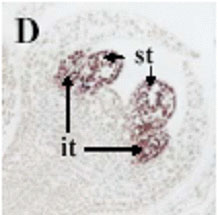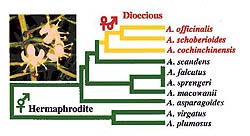| I. Mechanism
of sex determination in dioecious plant, asparagus |
|
|
1.
Isolation and characterization of floral homeotic
genes
|
Garden asparagus (Asparagus officinalis L.) is a dioecious species, possessing male and female flowers on separate unisexual individuals. Since B- and C-functional MADS-box genes specify male and female reproductive organs, it is important to characterize these genes to clarify the mechanism of sex determination in monoecious and dioecious species. We isolated and characterized class B and C genes from asparagus. Those genes are specifically expressed in flower bud.
|

Fig. In situ hybridization of AODEF, one of class B gene, in male flowers at hermaphroditic stage (stages -3 to -2). The hybridization signal is present in the inner tepals and stamens.
|
Reference:
J.-H. Park, Y. Ishikawa, R. Yoshida, A. Kanno and T. Kameya
Expression of AODEF, a B-functional MADS-box gene, in stamens and inner tepals of dioecious species Asparagus officinalis L.
Plant Mol. Biol. (in press)
A. Kanno, J.-H. Park, P.-Y. Yun, H.-M. Choi, R. Yoshida and T. Kameya
Isolation and characterization of floral organ identity genes from Asparagus officinalis L.
Proceedings of Xth International Asparagus Symposium.
Acta Horticulturae 589:267-272 (2002)
|
|
| II. Genetic
variation among Asparagus species |
2. Phylogenetic analysis
|
Genus Asparagus includes some ornamental species and some medicinally important species, and distributed on dry land in the Old World. To clarify the phylogenetic relationships within this genus, we compared the restriction sites of chloroplast DNAs among ten species: A. officinalis, A. cochinchinensis, A. schoberioides, A. asparagoides, A. falcatus, A. macowanii, A. plumosus, A. scandens, A. virgatus and A. sprengeri. Three dioecious species, A. officinalis, A. cochinchinensis and A. schoberioides, were grouped into one cluster, which suggests the possibility that dioecy in the genus Asparagus might have had a monophyletic origin.
|

Fig. Phylogenetic tree based on RFLP of chloroplast DNA.
|
Reference:
Y-O. Lee, A. Kanno and T. Kameya
Phylogenetic relationships in genus Asparagus based on the restriction enzyme analysis of the chloroplast DNA.
Breeding Sci. 47:375-378 (1997)
A. Kanno, Y-O. Lee and T. Kameya
The structure of the chloroplast genome in members of the genus Asparagus.
Theor. Appl. Genet. 95:1196-1202 (1997)
|
3. Interspecific hybrid
|
Interspecific hybrids are very important breeding materials to introduce new genes from wild species into crop plants, and useful tool to obtain cytological and genetic information about related species. We consider that interspecifc hybrid of genus Asparagus including both dioecious and hermaphrodite species apply to the research about the evolution of sex determination mechanism. So we have attempted to produce interspecific hybrids between various Asparagus species. We have already obtained interspecific hybrid between A. officinalis (garden asparagus, dioecious species) and A. schoberioides that is dioecious species distributed in China, Korea and Japan.
|

Fig. Interspecifc hybrid between A. officinalis and A. schoberioides.
|
Reference:
T. Ochiai, T. Sonoda, A. Kanno and T. Kameya
Interspecific hybrids between Asparagus schoberioides Kunth. and A. officinalis L.
Proceedings of International Asparagus Symposium.
Acta Horticulturae 589:225-229 (2002)
|